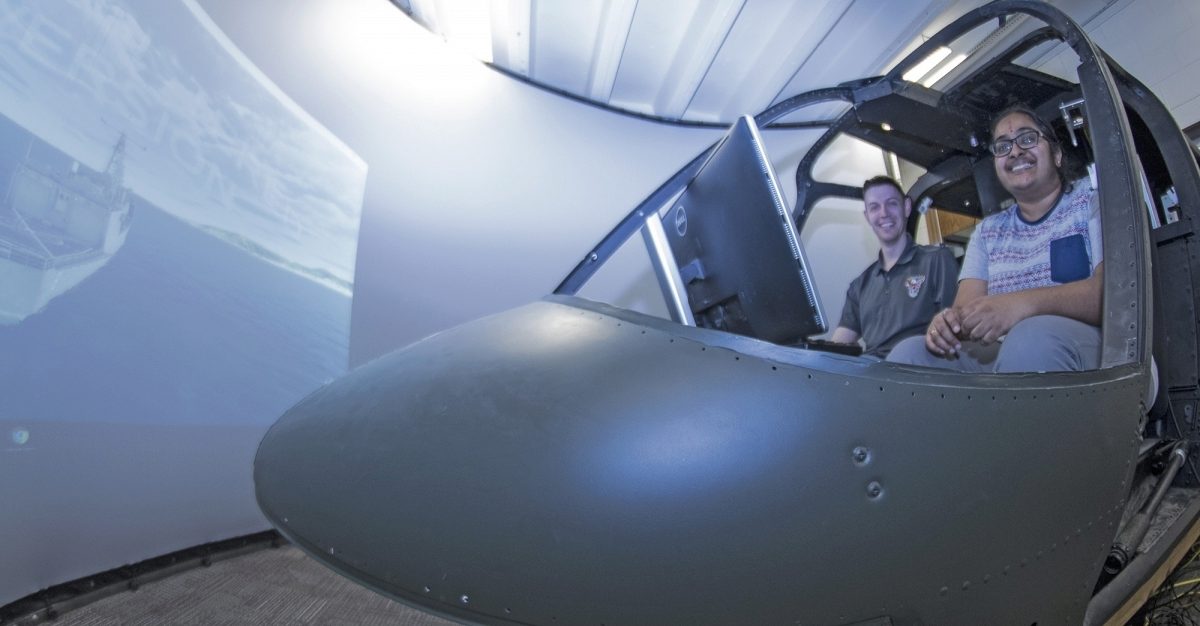
SIMULATING SAFETY. Grad students Robert Walters and Vinodhini Comandur are among several researchers who have already begun to use the rotorcraft simulation lab to investigate new techniques for improving rotorcraft safety. Their paper on this subject, "Model Predictive Path Integral Approach for Trajectory Guidance of Rotorcraft Shipboard Landing" will be presented at the American Helicopter Society's Forum this spring.
A new rotorcraft simulation lab in the Montgomery Knight building is quietly revolutionizing the Aerospace Engineering School’s research capabilities. And it’s not even fully outfitted yet.
 |
| Prof. J.V.R. Prasad |
“We will be installing a bank of pilot controls, designed by MOOG, later this spring,” explains AE professor J. V. R. Prasad, who spear-headed the effort using a Department of Defense University Research Instrumentation Program (DURIP) grant from the Office of Naval Research (ONR). “Together with the simulation software, we will be able to fully simulate the pilot experience under multiple conditions.”
Even without those controls, the rotorcraft simulation lab is something of a video game come to life. Outfitted with an actual Bell Helicopter- OH58 (206) cab, it has a 270-degree screen that displays images that match simulated flying conditions – choppy winds, dense fog, starless darkness, or bright sunlight. Computer models provided by Advanced Rotorcraft Technology, Inc., provide researchers with a picture of how the vehicle responds to those conditions.
With these elements, alone, three research projects have already launched, and more will follow, Prasad predicts.
“This is a departmental resource that will help all sorts of research,” says Prasad.
 |
| Prof. Karen Feigh Cognitive Engineering Center |
Prasad’s own project involves a collaboration with AE professors Karen Feigh and Evangelos Theodorou that seeks to improve the safety and efficiency of shipboard landings. The team is using a Model Predictive Path Integral (MPPI) approach to fine-tune software that will, ultimately, give pilots real-time feedback on the best flying strategy to pursue under different conditions.
“The goal is to create a flight path that takes into account all of the factors that can make landing difficult – the movement of the ship, the turbulence, the ocean – and puts it all into an augmented reality headset or, at least on their control panel, where the pilot can take the right action,” says Prasad.
“Every tenth of a second, we are able to compute thousands of trajectories that take into account all of those things while they continually update the path.”
Their research – supported by the U.S. Navy under the Vertical Lift Research Center of Excellence (VLRCOE)- is focused on developing a guidance algorithm that can display real-time solutions directly to pilots as they approach a moving ship deck for a landing. While ‘pilot-in-the-loop’ simulation programs are not uncommon, the team has fine-tuned its approach to the problem, replacing model predictive methods with a MPPI approach that shows more promise.
 |
|
Prof. Evangelos Theodorou |
Prasad has co-authored a paper on their work, “Model Predictive Path Integral Approach for Trajectory Guidance of Rotorcraft Shipboard Landing” that will be presented at the American Helicopter Society (AHS) Forum 74 this spring.
“In addition to getting enormous help from Bell – they donated and delivered the cab – we were able to construct the screens almost entirely using the Aero Maker Space equipment,” says Bob Walters, a former Army helicopter pilot and one of several grad students working with Prasad. “That cut down the cost of constructing those screens and gave us much greater control over the final result.”
Behavioral research, conducted by Feigh and Dr. Dev Minotra of the Cognitive Engineering Center, has put a finer point on all of the work, helping the team to determine the most effective method for delivering guidance cueing to the pilot while in flight. Depending on the flight conditions or the type of maneuvers needed, the flight path information may be communicated using visual, audio, tactile or a combination of methods.
The application of this research to military projects is clear, but, in the end, Prasad’s team has built a lab, fine-tuned a software package, and developed practical technical support that promise to improve rotorcraft safety, efficiency, and durability.
"Shipboard landing has been a huge challenge for many years, and this lab is changing that by helping us come up with systems that account for all of the uncertainties " says Prasad.
"But this lab is also allowing some great research on extending [rotorcraft] component life [ J.V.R. Prasad, Massimo Ruzzene and Julian Rimoli] and is the foundation for some other research on multi-rotor inflow models [J.V. R. Prasad, Lakshmi Sankar and Dave Peters]."
This spring, the lab will undergo its first major test, when Prasad lets a group of Navy test pilots take it out for a spin. The pilots will fly different approach patterns under different conditions to test its reliability. Ultimately, the software will be handed over to the Navy for formal integration into future fleets by a private contractor.
Walters is quick to point out that there already exists a thick manual that prescribes different flight strategies for pilots. The problem, he says, is two fold. First, the manual depends a lot on visual cues to correct the attitude of the vehicle; sometimes those cues are obscured or distorted. Then, there’s the very real distractions that crop up under emergency circumstances. A closed loop flight navigator, such as the one Prasad's team is developing, could allow pilots to focus on more mission-critical problems.
As a former medivac pilot in the Army, Walters knows a few things about those emergencies. He also knows how time-consuming it is to use that manual to create a flight plan.
"When I was deployed in Afghanistan, I knew there was a better way to do this, so I taught myself some programming and ended up cutting my pre-mission planning from 20 minutes to 15 seconds,” he says.
That same drive for a simplified and dependable guidance system led him to pursue his master’s degree under the tutelage of Prasad.
“For pilots, there’s a reality to being ‘behind’ the aircraft or ‘ahead’ of it, mentally. What we’re trying to do here is important because we’re putting the pilot ahead of the aircraft, where he can anticipate longer-term aspects of the mission – like finding the missing person or delivering supplies. If they can focus less on the variable conditions, they pay more attention to the conditions that affect their overall mission."
 INSIDE THE COMMAND CENTER. Dr. Dev Minotra, left, of the Cognitive Engineering Center, shares a moment in the rotorcraft simulator with grad student Bob Walters, right.
INSIDE THE COMMAND CENTER. Dr. Dev Minotra, left, of the Cognitive Engineering Center, shares a moment in the rotorcraft simulator with grad student Bob Walters, right.